Standards Worldwide
Standards Worldwide
Phone +49 30 58885700-07

Standard [CURRENT]
ASTM F 3047M:2023
Standard Guide for High Demand Hip Simulator Wear Testing of Hard-on-Hard Articulations
- Publication date
- 2023
- Original language
- English
- Pages
- 8
- Publication date
- 2023
- Original language
- English
- Pages
- 8
- DOI
- https://dx.doi.org/10.1520/F3047M-23
Product information on this site:
Quick delivery via download or delivery service
Buy securely with a credit card or pay upon receipt of invoice
All transactions are encrypted
Short description
1.1 The objective of this guide is to advise researchers on the possible high demand wear test features that should be included in evaluation of hard-on-hard articulations. This guide makes suggestions for high demand test features that may need to be added to an overall wear test regime. Device articulating components manufactured from other metallic alloys, ceramics, or with coated or elementally modified surfaces without significant clinical use could possibly be evaluated with this guide. However, such materials may include risks and failure mechanisms that are not addressed in this guide. 1.2 Hard-on-hard hip bearing systems include metal-on-metal (for example, Specifications F75 , F799 , and F1537 ; ISO 5832-4, ISO 5832-12), ceramic-on-ceramic (for example, ISO 6474-1, ISO 6474-2, ISO 13356), ceramic-on-metal, or any other bearing systems where both the head and cup components have high surface hardness. An argument has been made that the hard-on-hard THR articulation may be better for younger, more active patients. These younger patients may be more physically fit and expect to be able to perform more energetic activities. Consequently, new designs of hard-on-hard THR articulations may have some implantations subjected to more demanding and longer wear performance requirements. 1.3 Total Hip Replacement (THR) with metal-on-metal articulations have been used clinically for more than 50 years ( 1 , 2 ) . 2 Early designs had mixed clinical results. Eventually they were eclipsed by THR systems using metal-on-polyethylene articulations. In the 1990s the metal-on-metal articulation again became popular with more modern designs ( 3 ) , including surface replacement. 1.4 In the 1970s the first ceramic-on-ceramic THR articulations were used. In general, the early results were not satisfactory ( 4 , 5 ) . Improvement in alumina, and new designs in the 1990s improved the results for ceramic-on-ceramic articulations ( 6 ) . 1.5 The values stated in SI units are to be regarded as the standard. 1.6 This standard does not purport to address all of the safety concerns, if any, associated with its use. It is the responsibility of the user of this standard to establish appropriate safety, health, and environmental practices and determine the applicability of regulatory limitations prior to use. 1.7 This international standard was developed in accordance with internationally recognized principles on standardization established in the Decision on Principles for the Development of International Standards, Guides and Recommendations issued by the World Trade Organization Technical Barriers to Trade (TBT) Committee.
ICS
11.040.40
DOI
https://dx.doi.org/10.1520/F3047M-23
Also available in
Loading recommended items...
Loading recommended items...
Loading recommended items...
Loading recommended items...
